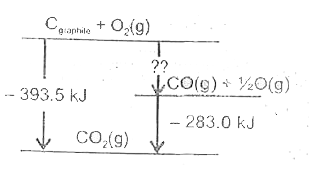The enthalpy change for the reaction 2C(graphite)+3H2(g)→C2H6(g) is called
Enthalpy of formation
Enthalpy of combustion
Enthalpy of hydrogenation
Enthalpy of vaporisation
The correct Answer is:A
To determine the enthalpy change for the reaction
2C(graphite)+3H2(g)→C2H6(g)
we need to identify what this enthalpy change is called.
1. Identify the Reaction: The given reaction involves the formation of ethane (C2H6) from its constituent elements, which are carbon (in the form of graphite) and hydrogen (in the form of hydrogen gas).
2. Understand Enthalpy Change: The enthalpy change associated with the formation of a compound from its elements in their standard states is known as the enthalpy of formation.
3. Standard States: In this reaction, carbon is in its standard state as graphite, and hydrogen is in its standard state as H2 gas. This is important because the enthalpy of formation is defined based on the elements being in their standard states.
4. Conclusion: Since the reaction describes the formation of ethane from its elements in their standard states, the enthalpy change for this reaction is called the "enthalpy of formation" of ethane.
Final Answer:
The enthalpy change for the reaction 2C(graphite)+3H2(g)→C2H6(g) is called the enthalpy of formation of ethane.
---
The enthalpy change for the reaction 2C(graphite)+3H2(g)→C2H6(g) is called the enthalpy of formation of ethane.
Topper's Solved these Questions
- THERMODYNAMICS BOOK - ALLENCHAPTER - THERMODYNAMICS EXERCISE - EXERCISE -4
18 Videos
- THERMODYNAMICS BOOK - ALLENCHAPTER - THERMODYNAMICS EXERCISE - EXERCISE -2
100 Videos
- TEST PAPERSBOOK - ALLENCHAPTER - TEST PAPERSEXERCISE - MATHEMATICS
2 Videos
- Thermodynamics And Thermo ChemistryBOOK - ALLENCHAPTER - Thermodynamics And Thermo ChemistryEXERCISE - All Questions
40 Videos
Similar Questions
The enthalpy change for the reaction H2(g)+C2H4(g)→C2H6(g) is ……………… The bond energies are, H−H=103,C−H=99,C−C=80 & C=C=145K cal mol−1
View SolutionGiven the bond energies N−N , N−H and H−H bond are 945,436 and 391KJmol−1 respectively, the enthalpy change of the reaction
N2(g)+3H2(g)→2NH3(g) is
View SolutionUsing the bond enthalpy data given below, calculate the enthalpy change for the reaction
C2H4(g)+H2(g)→C2H6(g)
Data:BondBond enthalpyC−C336KJmol−1C=C606KJmol−1C−H410KJmol−1H−H431KJmol−1
View SolutionThe enthalpy change for the process
C(graphite)→C(g)is called
View SolutionA schematic representation of enthalpy changes for the reaction,Cgraphite+12O2(g)→CO(g) is given below. The missing value is

View SolutionThe enthalpy change (ΔH) for the reaction
N2(g)+3H2(g)→2NH3(g)
is −92.38kJ at 298K. What is ΔU at 298K?
View SolutionThe enthalpy of formation of ammonia is −46.0KJmol−1 . The enthalpy change for the reaction 2NH3(g)→N2(g)+3H2(g) is :
View SolutionΔH∘1 for CO2(g), CO(g) and H2O(g) are −393.5,−110.5 and −241.8kJmol−1 respectively. Standard enthalpy change for the reaction
CO2(g)+H2(g)→CO(g)+H2O(g) is
View SolutionThe enthalpy change for the reaction, C2H6(g)→2C(g)+6H(g) is X kJ. The bond energy of C-H bond is :
View SolutionThe enthalpy change (ΔH) for the reaction, N2(g)+3H2(g)→2NH3g is −92.38kJ at 298K What is ΔU at 298K?
View Solution
